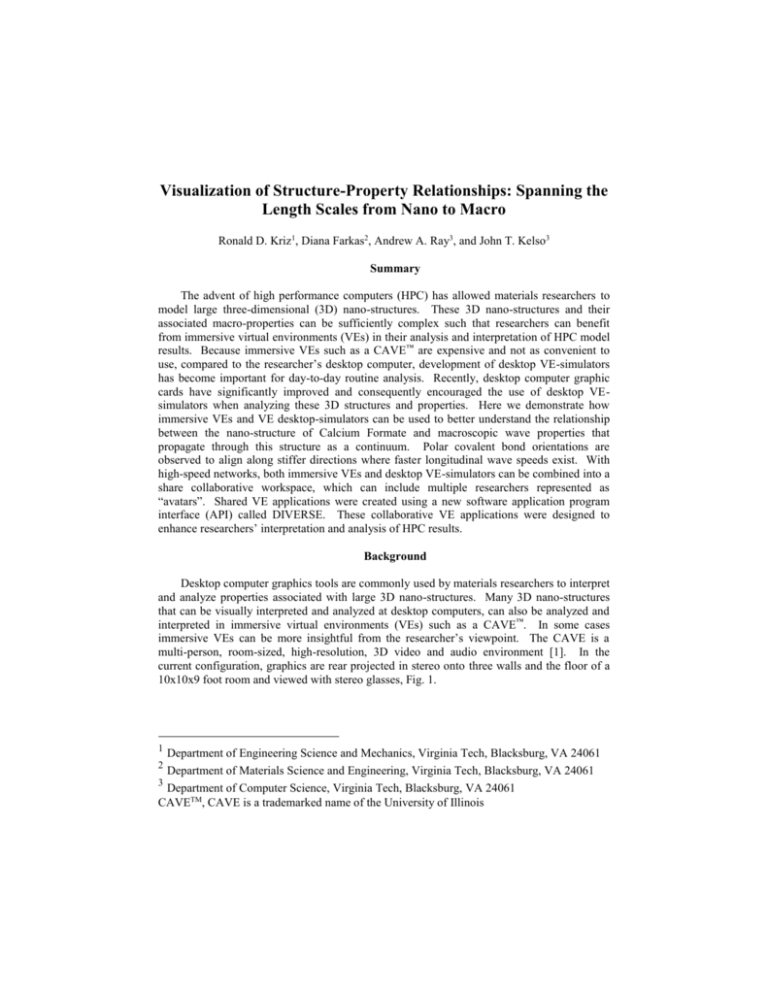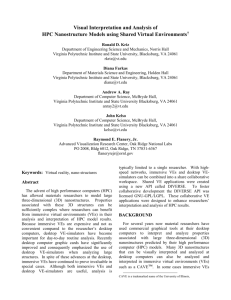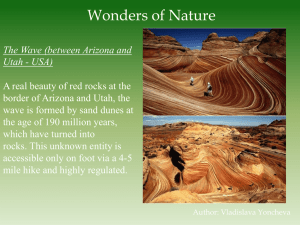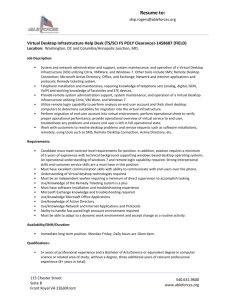icces03
advertisement

Visualization of Structure-Property Relationships: Spanning the Length Scales from Nano to Macro Ronald D. Kriz1, Diana Farkas2, Andrew A. Ray3, and John T. Kelso3 Summary The advent of high performance computers (HPC) has allowed materials researchers to model large three-dimensional (3D) nano-structures. These 3D nano-structures and their associated macro-properties can be sufficiently complex such that researchers can benefit from immersive virtual environments (VEs) in their analysis and interpretation of HPC model results. Because immersive VEs such as a CAVE™ are expensive and not as convenient to use, compared to the researcher’s desktop computer, development of desktop VE-simulators has become important for day-to-day routine analysis. Recently, desktop computer graphic cards have significantly improved and consequently encouraged the use of desktop VEsimulators when analyzing these 3D structures and properties. Here we demonstrate how immersive VEs and VE desktop-simulators can be used to better understand the relationship between the nano-structure of Calcium Formate and macroscopic wave properties that propagate through this structure as a continuum. Polar covalent bond orientations are observed to align along stiffer directions where faster longitudinal wave speeds exist. With high-speed networks, both immersive VEs and desktop VE-simulators can be combined into a share collaborative workspace, which can include multiple researchers represented as “avatars”. Shared VE applications were created using a new software application program interface (API) called DIVERSE. These collaborative VE applications were designed to enhance researchers’ interpretation and analysis of HPC results. Background Desktop computer graphics tools are commonly used by materials researchers to interpret and analyze properties associated with large 3D nano-structures. Many 3D nano-structures that can be visually interpreted and analyzed at desktop computers, can also be analyzed and interpreted in immersive virtual environments (VEs) such as a CAVE™. In some cases immersive VEs can be more insightful from the researcher’s viewpoint. The CAVE is a multi-person, room-sized, high-resolution, 3D video and audio environment [1]. In the current configuration, graphics are rear projected in stereo onto three walls and the floor of a 10x10x9 foot room and viewed with stereo glasses, Fig. 1. 1 Department of Engineering Science and Mechanics, Virginia Tech, Blacksburg, VA 24061 Department of Materials Science and Engineering, Virginia Tech, Blacksburg, VA 24061 3 Department of Computer Science, Virginia Tech, Blacksburg, VA 24061 CAVETM, CAVE is a trademarked name of the University of Illinois 2 Because it is more convenient for researchers to work at their desktop computers, there was a need to extend visual analysis from the desktop to more insightful immersive VEs, such as a CAVE, when necessary. Hence, a new VE application program interface (API) called DIVERSE was created such that applications would scale from a desktop computer to an immersive VE such as a CAVE [2]. To foster collaboration and extensibility, the DIVERSE API was licensed open-source. D_Atomview [3] is an application that was created using the DIVERSE API. D_Atomview was used to interpret and analyze result of a 3D Nickel nanostructures predicted by high performance computer molecular dynamic models [4], Fig. 1. Figure 1. D_Atomview: a) right image, desktop CAVE VE-simulator embedded in a simple Nickel, Ni, nano-structure of 30,000 atoms, b) left image, actual snapshot of same structure projected onto the walls of a CAVETM, but VE immersion can only be experienced with stereo glasses while standing in the CAVE. D_Atomview can be networked together into a collaborative working environment, where multiple researchers are seen as “avatars”4 by using the DIVERSE dynamic shared object (DSO) called D_Collab_tool [5]. D_Collab_tool allows participants’ avatars to be loaded and unloaded dynamically while the D_Atomview application is running in “realtime”. With D_Collab_tool other graphical objects, that represent macro-properties, can be embedded into the associated nano-structure and shared dynamically with others working in the same VE space. Shared VEs can occur either at the desktop computer or in a CAVE. Problem Description There are many macro-properties that can be associated with any given nano-structure. Here we chose to work with a crystal of Calcium Formate, Ca[HCOO] 2 because of it’s unusual orthorhombic anisotropy. Orthorhombic symmetry reduces the fourth order elastic stiffness tensor, Cijkl, to nine independent components. Components of the fourth order tensor are macro-properties associated with the alignment and orientation of polar covalent bonds between atoms, which are represented by rods shown in Fig. 2a. For long wavelengths propagating along principal material axes, xi, waves “see” the material as a continuum and the corresponding wave speeds (macro-properties) are related to individual terms of the fourth order tensor. For example, waves propagating along the x1 axis: the longitudinal wave speeds are given by ( C1111 / )1/2 = ( C11 / )1/2 and two transverse wave speeds are given by ( C 1212 / 4 Avatar is a Hindu name describing a graphical representation of a deity in human form. )1/2 = ( C66 / )1/2 and ( C1313 / )1/2 = ( C55 / )1/2. Similarly for waves propagating along the x2 and x3 axis only the diagonal terms of the 6x6 stiffness matrix C, written in contracted Voigt notation where = 1,2,3,4,5,6, define the geometry of wave speeds along those axes. Wave velocities off-axis form 3D wave-velocity sheets that correspond to the collection of all terms of the fourth order stiffness tensor, defined by Christoffel’s equations of motion [6, 7], [ C ijkl j l - v 2 ik ] i = 0, (1) where i is the “pointing” or propagation direction, is the density, v is the wave velocity (eigen-values), and i is the wave displacement vibration direction (eigen-vectors). 2D versus 3D Topologies That Show Structure-Property Relationships The collection of velocities corresponding to directions i in the x1-x2 plane maps out the 2D wave-velocity surfaces shown in Fig. 2b. The outer-most wave-velocity surface corresponds to the fastest quasi-longitudinal (ql) wave and the inner two wave surfaces are quasi-transverse (qt) and pure transverse (t). Figure 2. Calcium Formate: a) left image, unit cell nano-structure Ca[HCOO]2 in x1-x2 plane, b) right image, macro-property wave velocities (m/s) in x1-x2 plane for three waves. Figure 3. Calcium Formate 2D wave velocities (m/s): a) left image, x1-x3, b) center image, x2-x3 plane, c) right image, isometric view of velocities in all three planes showing a single connected wave-velocity surface. Calcium formate exhibits an unusual wave 3D wave-velocity surface topology, where all three wave-velocity surfaces combine into a single connected surface, Fig. 3c. This unusual topology is uniquely defined by the inequality C 11>C33>C66>C22>C55>C44, [7]. This and other unusual topologies have been used for sub-classification within orthorhombic symmetry [6]. Although the simple schematic in Fig. 3c shows connectivity, the entire 3D wavevelocity surface is not shown. In Fig. 3c connectivity occurs at wave-velocity intersection points a, b, c, and d, which are shown only in principal material planes. Perhaps similar points occur away from the principal material planes. The entire 3D wave-velocity surface is created by solving Christoffel’s equation for velocities, v, in all possible propagation directions, k, away from the principal planes. Displacement vibration directions, k, are mapped as color onto these velocity surfaces [9]. Since velocities, v, and their vibration directions, k, are only functions of Cijkl, these 3D wave-velocity topologies uniquely represent the fourth order stiffness tensor, Cijkl, Fig 4. Figure 4. Wave-velocity 3D surface topology for Calcium Formate. Outer two surfaces are translucent which shows all three velocity-surfaces and their intersections. Closer observation of these 3D topologies in an immersive VE revealed that no new velocity intersection points occur outside principal material planes. These observations were only possible in an immersive VE. Hence, starting the analysis at the desktop VE-simulator, Fig. 4, and then moving results into the CAVE (not shown) proved to be necessary. Studying structure-property relationships for Calcium Formate was accomplished by embedding a collection of unit cells (2 unit cells in the x1 and 3 in the x2 and x3 directions) into the wave-velocity surface topology, Fig. 5. Again the immersive VE proved useful. In a CAVE, researchers can “immerse” themselves in the structure and observe that the polar covalent bonds align themselves along stiffer directions where faster longitudinal wave velocity appear as bulges in the surfaces. This can also be seen in Fig. 2 where the polar covalent bonds are aligned diagonally and match with faster wave propagation directions. This demonstrates that immersive VEs such as a CAVE are useful but not always necessary. Figure 5. Calcium Formate 2x3x3 unit cell nano-structure shown in Fig. 2a is embedded in macro-property wave-velocity surface topology and shown here on a desktop computer using the D_collab_tools at a desktop computer running the DIVERSE VE-simulator. Discussion of Results and Future Opportunities The advent of high performance computing (HPC) has created a data-rich but information-poor working environment for materials researchers interested in interpretation and analysis of HPC results of large-scale nano-structures. Graphical representation of complex nano-structures and their corresponding macro-properties is now possible at desktop computers because of high-speed graphics cards and new open-source graphics software applications and their APIs. Many of these desktop graphics applications are now routinely used to assist in the interpretation and analysis of HPC results. New graphical APIs such as DIVERSE allow researchers to work both at their desktop and in immersive VEs as necessary. This was demonstrated by using D_collab_tools to study the nano-structure and macro-properties of waves propagating through a crystal of Calcium Formate embedded in 3D translucent wave-velocity surfaces that represent the fourth order stiffness tensor of the same material. Immersive VE environments were more useful when analyzing wave-velocity (macro-properties) topologies. Immersive VEs such as a CAVE proved useful but not necessary when studying structure-property relationships for the same crystal. Polar covalent bonds were observed to align with faster longitudinal wave velocity propagation directions both at the desktop computer using VE-simulators and in the CAVE. With D_Atomview it may be possible to observe these stiffer directions as molecular dynamic vibration animations. Future opportunities in the area of visual analysis and interpretation of HPC results exist because of the growing trend in faster, cheaper, and easier-to-use desktop computers. Faster numerical calculations allow researchers to study larger problems. Faster graphics hardware transforms data data-rich HPC results into meaningful information-rich 3D images and animations. Someday computer graphical models, like mathematical models, will become an integral part of how we model, create, and understand our physical world with psychical images. References 1. What is a CAVE?: http://www.sv.vt.edu/future/vt-cave/whatis/ 2. DIVERSE (2001): http://diverse.sourceforge.net 3. DIVERSE Atomview (2002): http://www.sv.vt.edu/future/cave/software/D_atomview/ 4. Farkas, D, Van Swygenhoven, H., Derlet, P. M. (2002), “Intergranular Fracture in Nanocrystalline Metals”, Phys Rev B 66, pp. 060101-060104. 5. DIVERSE Collab Tools (2003): http://www.sv.vt.edu/future/cave/software/D_collabtools/ 6. Musgrave, M.J.P.(1981), "On an Elastodynamic Classification of Orthorhombic Media", Proc. R. Soc. Lond. A374, p. 401. 7. Ledbetter, H.M. and Kriz. R.D.(1982), "Elastic-Wave Surfaces in Solids", Physica Status Solidi 114, pp. 475-480. 8. Kriz, R.D., and Ledbetter, H.M.(1986), "Elastic Wave Surfaces in Anisotropic Media", Rheology of Anisotropic Materials, C. Huet, D. Bourgoin, and S. Richemond, Eds., CEPADUES-Editions, Toulouse, France, pp. 79-91. 9. Kriz, R.D., Farkas, D., and Batra, R.C.(2002), “NSF-Combined Research and Curriculum Development: Computer Simulation of Material Behavior -From Atomistic to The Continuum Level”, Course module: Introduction to Mechanical Behavior of Anisotropic Quotes on Visual Thinking: http://www.sv.vt.edu/classes/ESM4714/Gen_Prin/vizthink.html Materials: http://www.jwave.vt.edu/crcd/kriz/lectures/Anisotropy.html








